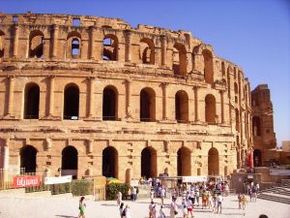Tunisia Travel Guide
Located at the border with Algeria and Libya, Tunisia is the smallest country from Maghreb with a surface of only 162.000 square km. The national language is Arab but French is also spoken while the major religion is Muslim.
Its geography comprises The Atlas Mountains, the Medjerda river, Sahara and some salted lakes. Its climate varies from Mediterranean in the north to desert in the south. So it is not a good idea to visit the country in July or August when temperatures can reach 40-50 degrees Celsius. It’s better to choose spring and autumn for your visit. Spring offers magnificent sights with flowers in bloom while autumn offers warmer water for swimming. If you happen to go to the desert in winter you should expect very cold nights.
The best way to get to Tunisia is by air, the ferry is too expensive, and it is not a good option to take your own car even if renting it here is a bit expensive. It is cheaper if you make the arrangements for renting the car before you leave home.
You don’t need a visa to enter the country if you are American, Canadian or come from the UE. You can stay up to 3 months and if you want to stay longer you should turn to the authorities. You can get in as much currency as you like but you can’t bring in or take out the local currency, but there are exchange offices opened in airports nonstop especially when there is an international flight. Banks though close at 11 am in summer and are opened from 7 am. Credit cards are not very useful here. You don’t need to present any vaccination when you enter the country but you should be aware of the danger of getting sun burnt, indigestion, rabies, cholera or other infectious diseases.
A good way of preventing getting sick is not to drink tap water and food sold in the street should be well chosen as it can be stale. Drink plenty of water, consume more salt and avoid the hot afternoon sun.
The country’s economy is based on textile, olive oil, petrol and other. Agriculture is not at its peak here. Tourism though has flourished in the last period and there’s been a constant effort of promoting it.
What to pack: if you travel in autumn you should pack warmer clothes for the night and a raincoat as you might get some heavy rain. Summer being very hot, a hat and sun lotion is essential.
The best way to communicate with your friends at home is by calling them as the internet connections at hotels are not very good.
If you want to take your kids with you don’t have to worry, they will have a nice time at the beach playing in the sand and swimming while a walk with the camel will make them very happy. Mind the heat though and ask your tour operator if the hotel you want to stay has babysitting options.
Traveling around the city is easy there are signs in French too. You can travel by bus but it is not recommended for tourists as they are very crowded and never ask a local if it is the right bus or directions they might give you the wrong directions.
You can easily get lost in the desert and you should let the National Guard from Medenine know about your itinerary before you leave. Always take plenty of water with you, like 5 l/pers even for short trips. The best thing to do if you get lost is to stay in your car. Best period to travel in the desert are the months of May and October.
Things about Tunisia you may be interested in
Recent Travel Guides from Tunisia
According to a famous legend, this island was actually the place where various lotus eaters used to reside. That legend also says that the famous Greek king Ulysses halted for some time here, while he was sailing on the Mediterranean Sea. The history of Djerba is famous due to the multiple legends and to many changes it went through. Read more »
Djerba, Tunisia
In this Djerba Travel Guide you will be able to get an overview of Djerba so that you can plan your trip accordingly. The city of Djerba (also famous by the names of Girba, Jarbah, and Jerba) is part of Tunisia and is the largest of all the islands present around North Africa.... Read more »
Tunis, Tunisia
Tunisia has been termed as the kaleidoscope nation of Northern Africa. From Mediterranean beaches to the Sahara desert and from ancient souks to modern day malls, Tunisia has it all. This Arab-Berber nation is one of the most liberal in the Islamic world where alcohol is freely available and women need not feel intimidated. ... Read more »
Tunis, Tunisia
Tunisia has been termed as the kaleidoscope nation of Northern Africa. From Mediterranean beaches to the Sahara desert and from ancient souks to modern day malls, Tunisia has it all. This Arab-Berber nation is one of the most liberal in the Islamic world where alcohol is freely available and women need not feel intimidated.... Read more »
Tunis, Tunisia
Few people know that modern-day Tunisia was the center of the Carthaginian civilization; Carthage itself was located around 16km north of the present capital, Tunis. The town was originally named Tunes and was founded by the Berbers in the 2nd century BC. It was in the 9th century that the Phoenicians from the city of Carthage conquered Tunis.... Read more »


